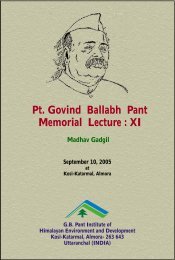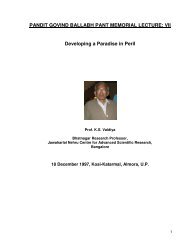Pandit Govind Ballabh Pant Memorial Lecture: II
Pandit Govind Ballabh Pant Memorial Lecture: II
Pandit Govind Ballabh Pant Memorial Lecture: II
You also want an ePaper? Increase the reach of your titles
YUMPU automatically turns print PDFs into web optimized ePapers that Google loves.
strengthened. If these are threatened, biodiversity is ipso facto threatened. This<br />
aspect already has been discussed by the author in detail (Khoshoo, 1991).<br />
Conservation of biota involves essentially long-range management. It is indeed a<br />
holistic concept and encompasses whole spectrum of activities from in situ<br />
conservation dealing with population, communities and ecosystems on the one<br />
hand, an don the other it deals with ex situ involving botanical gardens, arborea,<br />
zoos and zoological gardens, and biological banks for storing pollen, seed, sperm,<br />
egg, embryo, tissue, organ and genes. Fig. 9 summarizes different options available<br />
for conservation.<br />
Fig. 9: Options for conservation of biodiversity source: Khoshoo, 1992.<br />
A distinction has to be made between in situ and ex situ conservation. In situ<br />
conservation is indeed long-term management and with it is implicit that both<br />
ecological processes and organic evolution go on unhindered. Under ex situ<br />
conservation such processes are cut short. Obviously, ex situ does not have the<br />
benefit of continued organic evolution.<br />
A situation intermediate between in situ and ex situ occurs in wild lands in man<br />
made wilderness areas, or when such lands are converted for purposes of<br />
preserving/conserving biodiversity or genetic diversity. It is clear that right from<br />
acclimatization, biota in such habitats would face natural and / or human selection.<br />
This is not identical to what exists in their original habitats.<br />
In Situ Conservation<br />
As indicated earlier, in situ conservation aims at conserving biota in their natural<br />
habitats on a holistic basis more as a system than as separate individuals. The aim<br />
is to conserve an integrated system (ecosystem) of plants, animals and<br />
microorganisms with its particular atmosphere, hydrosphere and lithosphere. Under<br />
such conditions, there are opportunities for mutualism, co-adaptation and coevolution<br />
together with processes like mutation, recombination and natural selection,<br />
which work unfettered leading to the survival of the fittest (fig. 8). Ideally, the<br />
interacting system, called the ecosystem, has to be auto-sustainable and selfregenerating.<br />
There has to be no human-made perturbations unless warranted on<br />
scientific and technological grounds.<br />
Conservation of Watersheds: The first and the foremost under in situ category<br />
are the watersheds. These are not only rich in biodiversity but with these are<br />
intertwined with our long-range ecological security, and perpetuity of our glaciers<br />
and river systems. Thus first and foremost, all the watersheds of not only the main<br />
river systems Indus, Ganges and Brahmaputra, but all their tributaries together with<br />
their glaciers have to be conserved.<br />
Protected Area Network: Already there are a number of recognized protected<br />
areas –biosphere reserves, national parks, wildlife sanctuaries. Some are already in<br />
28











